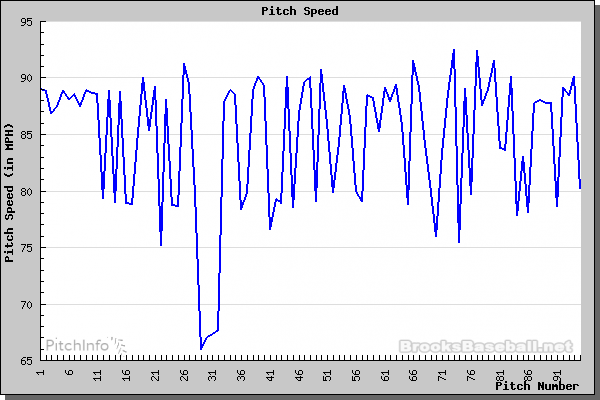Kyle Hendricks was the “other” prospect in the Ryan Dempster trade behind Christian Villanueva. Ostensibly part of Theo’s “get an arm in every trade” mantra, scouts didn’t think that highly of him, but he showed good control in the minor leagues.
Hendricks made his major league debut last Thursday for the Cubs. After a rough first-inning, he settled down and finished with a decent line: 6 IP, 5 H, 4 R, 7 K, 3 BB, 1 IBB. Three of the runs crossed the plate in the first, the other being a solo homer to Ryan Ludwick. According to PITCHf/x, he was in the strike zone on ~50% of his pitches, which is fine, and batters made contact with only ~83% of those pitches, which is good! On the other hand, he faced a Reds lineup without Joey Votto, Jay Bruce, Devin Mesoraco, Billy Hamilton, and Brandon Phillips, which is really bad.
The main thing that I was curious about with Hendricks was his velocity. Scouting reports we had heard coming into the game said that he threw four pitches: fastball, change, curveball, and cutter, with the ability to change speeds well and keep hitters off balance. The problem was that most reports had the fastball in the high-80s, 91 at best. Generally speaking, pitchers who throw 88 in the Major Leagues are either veterans who have lost velocity and managed to cope because they are veterans and full of wile, or pitchers whose teams would really rather they be in AAA or the bullpen.
The one exception to the velo reports was from John Arguello, who passed along a tidbit from Iowa manager Marty Pevey saying that Hendricks was hitting 95 “15-18 times per game.” Hitting 95 that frequently would indicate that it was well within his range. While that kind of jump would be pretty surprising, I didn’t dismiss it outright simply because Hendricks has seen a bump in his K-rate this year at Iowa, and if he were consistently throwing in the low-90s, it would be pretty easy to understand why. And of course, he’s the manager and he should really know that sort of thing.
It appears the Pevey report was an exaggeration. The five fastest pitches that Hendricks threw were in the 91-93 range. Interestingly, Brooks Baseball thinks that these were four-seam fastballs, a distinct pitch from the sinker that sat around 88. Perhaps it’s a new addition, given how infrequently he used it, though pitching coach Bruce Walton didn’t mention that before the start. Instead, he said that Hendricks was throwing a new changeup and curveball this season. (The change was reasonably effective on Thursday; Hendricks threw it 23 times, generating 17 swings, 7 whiffs, and one Ludwick HR).
On the whole, I don’t think the start changes our expectations much. There is a fine line between a back of the rotation innings-eater and a swingman/6th starter, between Travis Wood and Carlos Villanueva. Hendricks will have to consistently do the little things well to stay on the right side of that line. His performance in AAA this year has been promising, but whether or not it will translate is still an open question.

